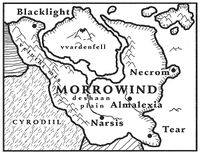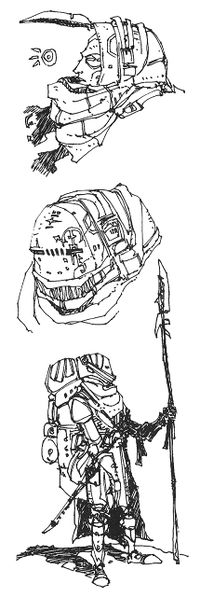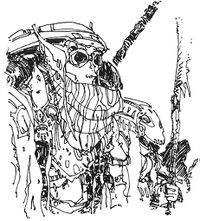The UESPWiki – Your source for The Elder Scrolls since 1995
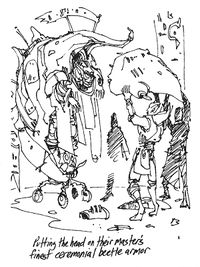
Putting the head on their master's finest ceremonial beetle armor
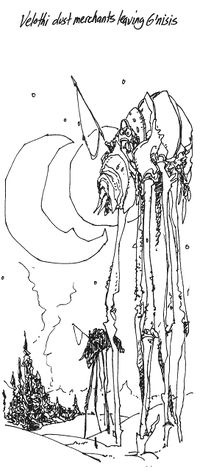
Velothi dust merchants leaving G'nisis
- Once a part of the First Empire of the Nords, Morrowind is now the land of the Dark Elves, whose origins are shrouded in mystery like the ash storms that regularly blanket their homeland. Savage and proud, the Dark Elves shun all contact with the outside world, even with their brethren from Valenwood and the Summerset Isles. The traveler, upon crossing Shadowgate Pass, may be forgiven for believing that he has left Tamriel and entered a different world. The sky is darkened regularly by furious ash storms belched forth from the mighty Vvardenfell volcano. The familiar flora and fauna of Tamriel is exchanged for bizarre and twisted forms that can survive the regular ashfall. Cloaked and masked Dark Elves tend herds of giant insects. A courier clatters by on the back of a 20-foot-tall, crab like creature. Everywhere, cowering slaves - Argonian, khajiit, human - scurry to carry out the barked commands of their Dark Elven masters.
- The grey-skinned red-eyed Dark Elves seem admirably suited to their weird, ash-blighted region. They are known as the Dunmer in the Elven tongue, and now populate the great stretch of northeastern Tamriel between the Velothi Mountains and the sea, and between the southern edge of the Deshaan plain and the northern coast. But from whence these unusual people came, what were their race and lineage, or where their original home, ere they spread themselves over Morrowind and the Deshaan, are questions easier asked than answered. The Dark Elves must have split from the original trunk of the Elven race many long eons ago, for although unquestionably kin to the other Elves of Tamriel, the Dark Elves differ in many ways, not least in their striking appearance. His ash-grey skin and glowing red eyes makes a Dark Elf instantly recognizable, although few have seen one, as they rarely leave their homeland. Like all elves, they tend to be tall and gaunt, but the Dark Elves take the Elvish haughtiness to an extreme, viewing humans as no better than beasts, fit only to serve as slaves on the plantations of Tear.
- They consider themselves superior even to other Elves, who in their estimation are effete and decadent specimens of the pure Elven race.[YR 1] The earliest human records bearing on the subject (which must remain our best source until the archives of the High Elves are opened to Imperial scholars) are the sagas and chronicles of the Nords. The Nords gave to the region the name of Dunmereth from being the land of the Dunmer; but in earlier ages it was called by themselves Resdayn; and Imperial Librarian Elba Laskee traces the foundation of the Dark Elven nation back to above 3,500 years from the present time. Morrowind was not given its modern name until after the first eruption of Vvardenfell (see Places of Note - Vvardenfell).
- When first we hear of the Dark Elves, they were divided into numerous petty clans, half of whom were at war with the other half at any given moment. The Nord Sagas speak of Dark Elven warriors pledging themselves to any Nord chieftain who went to war with their clan enemies, a circumstance which undoubtedly facilitated their Conquest by the Nords. The Dark Elves appear in the written record in 1E416, during the War of Succession which destroyed the First Empire of the Nords: "And seeing that the Nords were divided, and weak, the Dunmer took counsel among themselves, and gathered together in their secret places, and plotted against the kinsmen of Borgas, and suddenly arose, and fell upon the Nords, and drove them from the land of Dunmereth with great slaughter." Thus ended the First Empire of men, at the hands of the Dark Elves. It is not for another two centuries that we first hear of the Tribunal, who perhaps arose to prominence in the ruin wrought by the first eruption of Vvardenfell, which laid waste at least half of Morrowind, and led to a permanent shift of population south towards the Deshaan, the broad southern plain which gradually slopes down into the dismal swamps of Black Marsh. Be that as it may, under the Tribunal cult the Dark Elven clans were finally welded into one nation, although clan rivalry remains bitter up to the present day, and the clans cooperate with one another only with reluctance.
- Five clans, known as the Great Houses - Indoril, Redoran, Telvanni, Dres, and Hlaalu - now entirely control the politics and trade of Morrowind, although in earlier times there appear to have been six. Each major clan is allied with numerous subclans, the alignment of which is more or less permanent, although it is not unheard of for a subclan to switch allegiances. In former times, the clans carried out their feuding with open warfare. This was forbidden under the Tribunal, but the clans still engage in bloody infighting through the unique institution of the Morag Tong, the sanctioned guild of assassins. Clans routinely hire the Morag Tong to eliminate their enemies, and the assassins of the Morag Tong may kill their assigned "marks" with impunity, as long as they conform to the obscure (but strict) rules of their guild. Such an arrangement strikes the citizen of the Empire as an outlandish barbarism, but, as with much in benighted Morrowind, seems well-suited to the savage temperament of the Dark Elves.
- Clan Indoril claims kinship with all three of the legendary Tribunes, which doubtless accounts for Indoril's preeminence among the five clans. Indoril's capital is Almalexia, also the capital of Morrowind itself, and the Tribunal priesthood (which is one and the same as the bureaucracy of civil government) is dominated by the Indoril and their subclans. Clan Redoran guards the western flank of Morrowind, and are known as the best warriors among the Dark Elves. Clan Telvani [sic] is the most xenophobic of a xenophobic race, shunning all contact with outsiders, preferring to tend their herds of giant insects amid the rocky hills and islands of the extreme northeast. Telvani [sic] bug-musk is a highly prized perfume among the Dark Elves, and their riding-insects command the highest prices in the markets of Almalexia and Narsis. Clan Dres rules the southern sweep of Morrowind, where the fertile Deshaan plain merges with the swamps of Black Marsh. The Dres are the great slave-traders and plantation owners of Morrowind. Thousands of wretched captives, mainly Argonians but including not a few khajiits and even Imperial citizens, pass through the infamous slave-pens of Tear, the Dres capital, from whence most find an early death on the plantations which surround that ill-omened city. Clan Hlaalu is the smallest and weakest of the five clans, clinging to Great House status in their ancient capital of Narsis. Traditional enemies of the Indoril, who have controlled the levers of government for 3,000 years, the continued resilience of the Hlaalu must inspire a certain respect. Merchants and traders in a land that despises outsiders, the Hlaalu nevertheless maintain a limited commerce with the Empire, trading stout Imperial broadcloth and Cyrodilic brandy for the elegant trinkets produced by the admittedly skilled craftsmer of Morrowind.
- Dark Elven warriors favor a wonderfully light armor made from the carapace of insects, covered over with a finely-woven cloak of spider silk, wrapped several times around the torso. A turban protects the head and face from the ubiquitous ash, with goggles of transparent resin; loose trousers and high boots completes the dress. While this makes for an outlandish appearance, the traveler will understand the utility of these garments the first time he is caught out of doors in one of the frequent ash storms without such protection. When indoors, Dark Elves shed these outer coverings, and luxuriate in a variety of richly-colored fabrics; sashes decorated with clan symbols are common, while cumbersome ceremonial costumes made from various parts of giant insects are the glory of those of the highest rank.
Places of Note:
- Almalexia
- The largest and oldest city in Morrowind, named for its patron goddess. Almalexia is truly an ancient city, possibly predating the Dark Elves. It is reputed to be built over the ruins of a vast Dwarven city, although the current inhabitants vigorously deny this. Here the intrepid traveler would find the center of the Tribunal cult, in the sprawling palace/temple of Mournhold, a city within the city. This is also the seat of government of the Dark Elves, where the priests of the Tribunal rule in the name of their legendary deities.
- Sotha Sil
- Many tales are told of this clockwork city of brass, hidden in the steaming swamps of southern Morrowind, the lair of the most mysterious member of the Tribunal. No reliable reports exist of its location, however, or if this city even exists outside of story and song.
- NecromNB 1
- "The City of the Dead", Necrom perpetuates a religious tradition that predates the Tribunal cult. From across Morrowind, Dark Elves of every clan bring their dead in solemn processions that can last for months. From the mainland, Necrom, with its lofty walls and white towers, appears to be an immense necropolis, an impression that is strengthened by the constant traffic of corpses across the causeway into the city, a traffic which never ceases, day or night. In fact, the city teems with life: a vast and complex heirarchy [sic] of priests and attendants whose sole duty is to prepare the dead for the afterlife and deposit their bodies with the appropriate ritual into the catacombs which honeycomb the rock beneath the city.
-
The Tribunal
- The strange heathen religion of the Dark Elves deserves special note. They worship three gods known as "the Tribunal", and believe these gods walk the earth and rule Morrowind directly. To an outsider, the priesthood of the Tribunal seems to be the true power in Morrowind - these Tribunes, if they ever existed, have not been seen in centuries. Each Tribune, who go by the barbaric names of Almalexia, Sotha Sil, and Vivek, has an eponymous city dedicated to its worship, and a palace/temple within each city where the god supposedly resides. The priests of the Tribunal cult are all-powerful in Morrowind; strange processions of fantastically garbed priests roam the land, selecting new candidates to serve the Tribunal, who are seized without resistance and never seen again.[YR 2]
|
-
Vvardenfell
- The vast Volcano of Tamriel, this giant mountain dominates the north of Morrowind. It is a small continent all to itself, riven from the rest of Morrowind by the remains of a colossal crater. On a clear day (an exceedingly rare event), the peak can be seen from Almalexia, 250 miles to the south. At the time of the Nord Conquest, a Dwarven kingdom flourished in the north of Morrowind, the region now covered by the Vvardenfell volcano. Indeed, this vanished realm gave its name to the mighty volcano that obliterated it - Vvardenfell is a Dwarven word meaning "City of the Strong Shield". It is not known whether the Dwarves of Vvardenfell were destroyed by the first eruption of the volcano, or whether they had already met the mysterious fate of their brethren across Tamriel (see Marobar Sul's Ancient Tales of the Dwemer for a full discussion of the disappearance of the Dwarves). Certainly, the Kingdom of Vvardenfell remained strong at the time of the Nord Conquest. The doughty Dwarves, secure in their underground fastnesses and united into one polity, were a far more formidable foe than the divided and feuding Dark Elven clans, and remained independent when the rest of Morrowind fell to the Nords. The volcano first erupted in 1E 668; this date, at least, is well attested in the written record. The eruption is still recalled in the tales of numerous peoples - to the Nords it was "The Year of Winter in Summer", to the khajiit, "Sun's Death". Legend attributes its birth to the fall of a god to earth; whatever the cause, Vvardenfell has slumbered uneasily for thousands of years, regularly blanketing the surrounding region with ash. Providentially, the tall mountain range between Morrowind and the rest of Tamriel has served to protect us from the exhalations of Vvardenfell, restricting its ash storms to the land of the Dark Elves, who seem made for life in its shadow.[YR 3]
|
- Annotations left by "¥R", an elven traveler sending this pamphlet to his uncle, are as follows:
-
| 1.^ |
For once I agree with this scribe. The tone of my visit was set at the frontier, when I was questioned by three swaggering chap'thil—called me "ill-bred" to my face as if I knew no Dunmeri, and had not even the courtesy to call me by my full name. I held my tongue, under the circumstances—I am not as young as I once was, Uncle!—But I relish the comeuppance at the hands of the despised humans. Despite everything, I cannot help but to think that a season under human rule would temper Dunmeri arrogance to a most salutary degree |
-
| 2.^ |
Uncle, what is the last confirmed record of the Tribunal? My tutor always answered my questions about their fate only with "All divine endure". Could Septim be the outsider prophesied by Lorkhan's cult? All signs point to the Tribunal's continued power, although dormant |
-
| 3.^ |
Septim is unaccountably interested in Dwemer artifacts—why? Useful military assets, true, but there is no evidence the Dwemer had much knowledge of magic-resistance—Dwemer war machines in our possession provide little more protection from standard transformation and field effects than our best metallurgy—What do we have in the archives on the Dwemer of Resdayn? Mechanists may have advanced far with Dunmer help in the years before Vvardenfell |
- Other notes:
